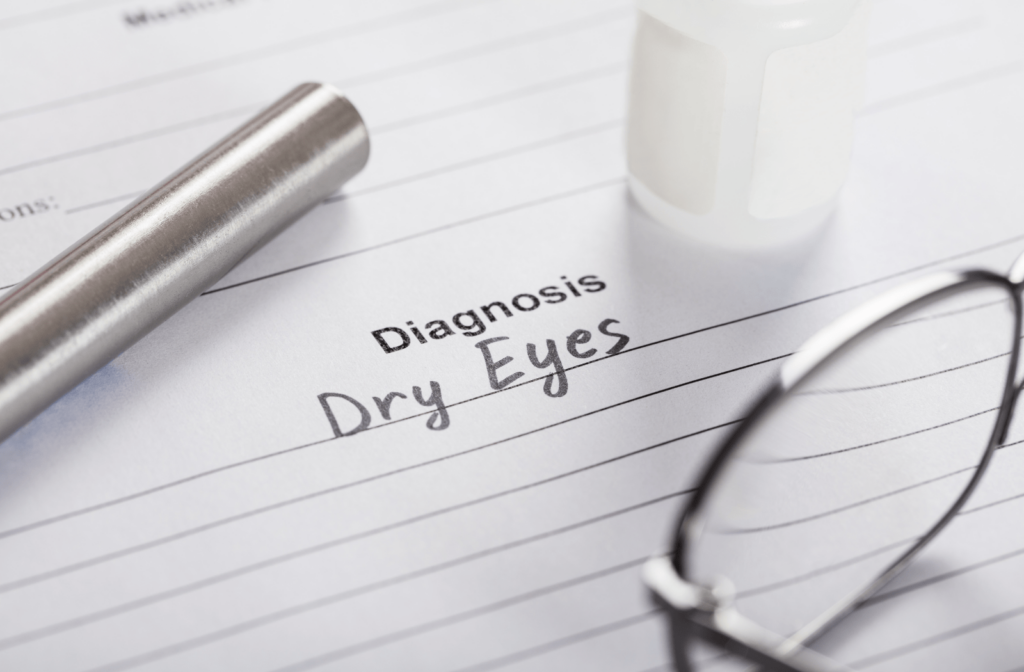Dry eye can significantly affect your quality of life, but treatment can help improve your symptoms. Before your eye doctor can begin treatment, they must diagnose your condition. They determine the cause of your dry eyes with a dry eye test.
Continue reading to learn more about dry eye, including why they develop, what a dry eye test is, and some of the tests your eye doctor may use during your eye exam.
What Is Dry Eye?
Dry eye is a common, chronic condition where your tears cannot effectively hydrate your eyes. This condition leads to uncomfortable symptoms like irritation, watery eyes, and blurry vision that approximately 16 million Americans experience.
Dry eyes occur because of complications related to your tear film, 3 layers that work together to keep your eyes moist and protected. When one or more of these layers has problems, it can lead to dry eye symptoms.
Dry Eye Symptoms
Common symptoms of dry eye include:
- Eyes that sting or burn
- Stringy mucus in or around the eyes
- Light sensitivity
- Red eyes
- Foreign object sensation
- Difficulty wearing contact lenses
- Watery eyes
- Blurry vision
- Eye fatigue
While many factors can affect dry eye development, you can experience 2 kinds of dry eye. You may experience dry eye symptoms due to a lack of tear production or faster evaporating tears. These conditions are known as aqueous tear deficiency and evaporative dry eye.
What Causes Dry Eye?
Dry eyes develop because of issues with the tear film. The different layers of the tear film (mucus, water, oil) work together to keep your eye hydrated and protect against bacteria.
The mucus layer of the tear film keeps tears fastened to the eye’s surface, helping them spread across evenly. The water level keeps the eye hydrated and protects against bacteria. The oil layer prevents tears from evaporating too quickly.
When issues arise in the tear film, it leads to aqueous tear deficiency, evaporative dry eye, or a combination of both.
Aqueous Tear Deficiency Dry Eye
Aqueous tear deficiency dry eye occurs when your eye’s lacrimal (tear) glands don’t produce enough water, leading to dry eyes. Around 1 in 10 patients experience this form of dry eye.
Age can be a common cause of aqueous tear deficiency dry eye—the body doesn’t produce as much water with time. Another possible cause is medical conditions like Sjogren’s syndrome.
Evaporative Dry Eye
You develop evaporative dry eye when your tear film doesn’t have enough oil to prevent evaporation. Your meibomian glands, the glands responsible for providing the oil in your tear film, can experience problems. When this happens, your tears evaporate too quickly, leading to discomfort.
Several factors can contribute to evaporative dry eye, including:
- Skin conditions like rosacea & psoriasis
- Long-term contact use
- Medications like antihistamines, antidepressants, or decongestants
- Certain diseases like diabetes or Sjogren’s syndrome
- Eye allergies
- Vitamin A deficiency
- Eye injury
- Eye surgery
What Is a Dry Eye Test?
A dry eye test is a way to diagnose dry eye, helping your eye doctor determine the cause of your symptoms. Your optometrist needs to identify what’s causing your irritation to ensure there isn’t another eye condition affecting you.
Additionally, they’ll learn more about your medical history to see if any conditions run in your family or if you’re at a higher risk of certain issues. You can expect several dry eye tests during your eye exam to help your eye doctor get a complete diagnosis.
Types of Dry Eye Tests
Your eye doctor has several dry eye tests they may use in your eye exam. These tests evaluate different aspects of your tear film and help determine the cause of your dry eye symptoms.
Some common dry eye tests include Schirmer’s test, slit-lamp examination, tear break-up time, and tear osmolarity.
Schirmer’s Test
Schirmer’s test helps your eye doctor determine if you’re making enough tears.
They administer numbing eye drops to improve your comfort before holding a small piece of paper along the edge of your eyelid. You close your eyes for 5 minutes, and your doctor evaluates how much moisture builds on the paper.
Slit-lamp Examination
A slit-lamp test involves using a microscope to examine your eyes. Your eye doctor shines a bright, thin light into your eye and looks at the eye’s surface and eyelids to see if you’re making enough tears.
Tear Break-Up Time (TBUT)
Tear break-up time helps assess how long your tears last after you blink. Your doctor places a small drop of dye into your eye—you then blink to cover your entire eye. You look forward without moving your eyes or blinking to help your doctor identify how long the dyed tears last before breaking up.
Tear Osmolarity Tests
Tear osmolarity tests evaluate the water quality of your tear film. Your tears have salt, and it’s necessary for proper tear production and distribution, but too little or too much can affect your tear quality. Testing the quality of your tear film can help your optometrist determine if you have dry eye.
Oculus Keratograph
The Oculus Keratograph 5M Topographer is a corneal topographer using a built-in real keratometer plus a color camera optimized for external imaging. This piece of technology can help your eye doctor determine if you have dry eye syndrome or dry eye disease.
Oculus analyzes your meibomian glands and noninvasive tear picture break-up time, and other parts of your cornea. Oculus also has the ability to compare your eyes before and after your treatment program so you can see the results. This treatment is non-invasive, and it only takes about 30 minutes to complete.
Identify the Root Cause of Your Symptoms
Dry eye can be irritating and uncomfortable, but your eye doctor can diagnose and treat this condition. After completing several dry eye tests, they can identify the cause of your symptoms. With their help, you can enjoy long-term comfort. Contact your optometrist if you’re experiencing dry eye symptoms.




